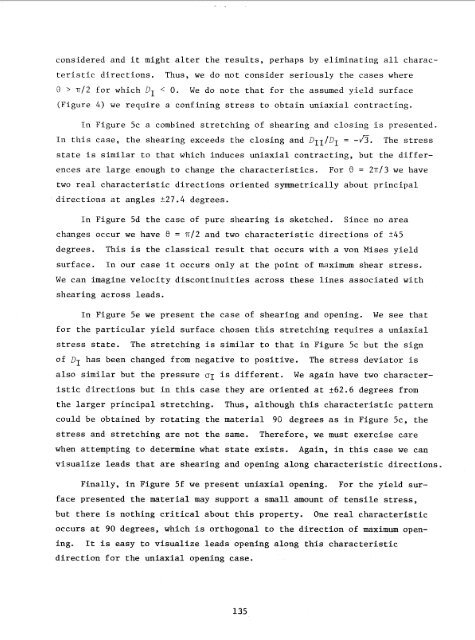AIDJEX Bulletin #40 - Polar Science Center - University of Washington
AIDJEX Bulletin #40 - Polar Science Center - University of Washington
AIDJEX Bulletin #40 - Polar Science Center - University of Washington
You also want an ePaper? Increase the reach of your titles
YUMPU automatically turns print PDFs into web optimized ePapers that Google loves.
considered and it might alter the results, perhaps by eliminating all charac-<br />
teristic directions. Thus, we do not consider seriously the cases where<br />
0 n/2 for which DI < 0. We do note that for the assumed yield surface<br />
(Figure 4) we require a confining stress to obtain uniaxial contracting.<br />
In Figure 5c a combined stretching <strong>of</strong> shearing and closing is presented.<br />
In this case, the shearing exceeds the closing and DII/DI = -6. The stress<br />
state is similar to that which induces uniaxial contracting, but the differ-<br />
ences are large enough to change the characteristics. For 8 = 2~13 we have<br />
two real characteristic directions oriented symmetrically about principal<br />
directions at angles k27.4 degrees.<br />
In Figure 5d the case <strong>of</strong> pure shearing is sketched. Since no area<br />
changes occur we have 8 = T/2 and two characteristic directions <strong>of</strong> ?45<br />
degrees.<br />
This is the classical result that occurs with a von Mises yield<br />
surface. In our case it occurs only at the point <strong>of</strong> maximum shear stress.<br />
We can imagine velocity discontinuities across these lines associated with<br />
shearing across leads.<br />
In Figure 5e we present the case <strong>of</strong> shearing and opening. We see that<br />
for the particular yield surface chosen this stretching requires a uniaxial<br />
stress state. The stretching is similar to that in Figure 5c but the sign<br />
<strong>of</strong> DI has been changed from negative to positive.<br />
also similar but the pressure 01 is different.<br />
The stress deviator is<br />
We again have two character-<br />
istic directions but in this case they are oriented at 262.6 degrees from<br />
the larger principal stretching. Thus, although this characteristic pattern<br />
could be obtained by rotating the material 90 degrees as in Figure 5c, the<br />
stress and stretching are not the same. Therefore, we must exercise care<br />
when attempting to determine what state exists. Again, in this case we can<br />
visualize leads that are shearing and opening along characteristic directions.<br />
Finally, in Figure 5f we present uniaxial opening. For the yield sur-<br />
face presented the material may support a small amount <strong>of</strong> tensile stress,<br />
but there is nothing critical about this property. One real characteristic<br />
occurs at 90 degrees, which is orthogonal to the direction <strong>of</strong> maximum open-<br />
ing.<br />
It is easy to visualize leads opening along this characteristic<br />
direction for the uniaxial opening case.<br />
135








